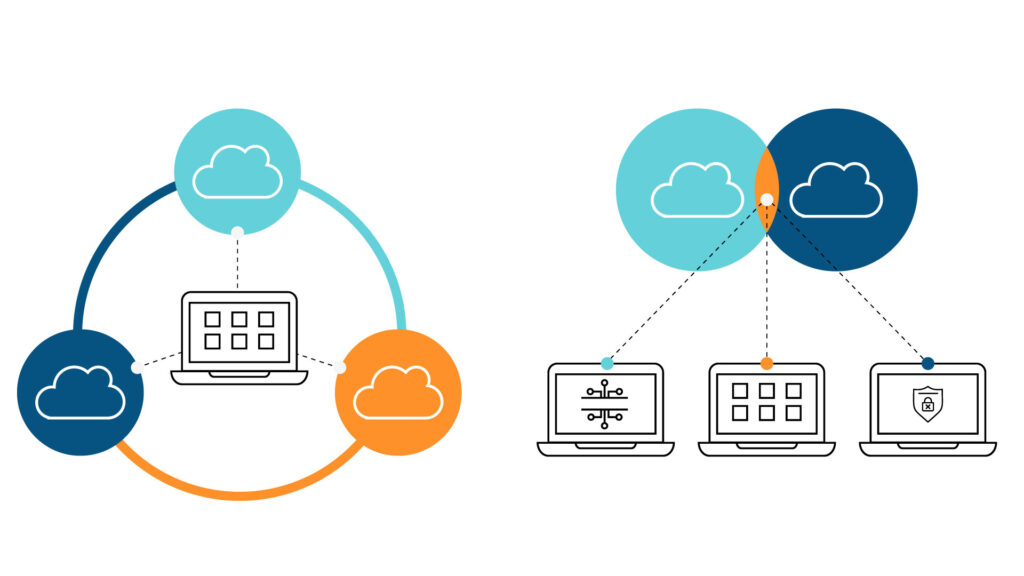There are numerous cloud strategies within each cloud ecosystem, and their design suits the infrastructure, security, workload, and many other requirements that each company has. Regarding hybrid cloud vs multi-cloud, they’re very similar, but their IT infrastructure models are not the same. Therefore, people often confuse a hybrid multi-cloud platform with being the same.
It’s not just another IT buzzword! These cloud models are real, and you must know as much about them as possible.
We want to help you understand what makes these two models different and which one of them would benefit your needs the most. Therefore, we’ll break down some critical questions, and the answers you get should give you better insight into which infrastructure model is perfect for your company’s needs.
In addition, we’ll cover in detail all their advantages and disadvantages, including their differences and similarities.
Let’s begin!

What is a Hybrid Cloud Infrastructure?
Hybrid cloud infrastructure has two or more different types of cloud environments. These environments include public cloud, private cloud, and on-premises. Within hybrid infrastructure, the public cloud can help extend the use of on-premises or private cloud environments.
A thriving hybrid cloud environment has some specific characteristics like:
- On-premises data center. Workloads and public or private cloud resources tied under single-governance management.
- Secure high-speed connectivity between cloud environment and enterprise.
- Resource and monitoring management.
- Multiple environments with centralized identity infrastructure.
- Integrated network creating a single segmented infrastructure.
What is a Multi-Cloud Infrastructure?
When it comes to multi vs hybrid cloud infrastructures, multicloud comes from different provides and spans across multiple public cloud environments. A multicloud infrastructure comprises from other public clouds that are often used for various tasks. One cloud can be utilized for databases, a second one for machine learning, the third one for program logic, etc. In addition, distribution across clouds is variable on a per-app basis.
If you’re wondering why should you decide on a multi-cloud infrastructure – here is why:
- If you’re using one public cloud provider but another offers a better-suited service you didn’t have with the initial provider.
- A diversified infrastructure is cost-effective and more efficient.
- If migrating the entirety of your services isn’t something you want to do.
Why do Many Organizations Use the Hybrid and Multi-Cloud Approach?

Hybrid Cloud
Many organizations choose a hybrid mix because it can create a flexible platform that meets a variety of your company’s needs. Some of these needs include security and flexibility.
Here’s what a hybrid cloud can do for your organization:
Improved scalability and control
Thanks to higher automation, users can adjust cloud settings to optimize performance, respond to in-demand changes, and efficiency
Reduced costs
Businesses can avoid massive capital expenditures to expand the infrastructure upon spikes in demand. Moreover, they’ll pay only for the cloud resources they utilize.
Security and risk management
An excellent hybrid cloud strategy includes control over your company’s data while improving security. This security improvement is reached thanks to reduced data’s potential exposure. A business can decide where they want to store its workloads and data. It is easier to implement solid technical security measures like access control, endpoint security, automation, encryption, and orchestration.
Access to data to better support remote workforce
Employees can access the data regardless of location and at any time. A hybrid cloud strategy provides your business with flexible support for remote employees thanks to on-demand data access as it isn’t tied to a single centralized location.
Based on your company’s priorities, you’ll need to weigh all hybrid cloud solutions’ pros and cons.
Multi-Cloud
A multi-cloud strategy allows your business to invest in digital transformation. In addition, your company won’t depend on one service provider.
Here’s why a multi-cloud solution is helpful:
Automation & Scalability
It doesn’t matter how much data you work with because a multi-cloud strategy allows you to store all your data. Moreover, this strategy helps companies manage hybrid workflows and coordinate disparate workloads. Due to automation, your business will benefit thanks to the efficient arrangement of apps, data, and infrastructure found across multiple cloud environments.
Robust Security
Data protection is cloud providers’ responsibility. Providers must prove that they can keep the infrastructure secure so all your data is adequately protected.
Risk Reduction
In case a cloud provider has a temporary failure or some other issue, you’ll notice the difference due to a decrease in performance. Thankfully, a multi-cloud strategy allows you to hop to another vendor if something like this ever happens.
Depending on your organization’s needs, a multi-cloud strategy may be a perfect solution. However, you’ll need to learn everything about multi-cloud pros and cons first.
Key Elements of a Hybrid Multi-Cloud Strategy
Multi-cloud vs hybrid cloud refer to specific cloud deployments comprising of more than just one cloud. However, they aren’t the same based on included cloud infrastructure.
Multi-cloud resembles a mix of different apple types, while hybrid cloud is a mix of pears and apples.
Similarities
Multi-cloud vs hybrid cloud methodologies have several aspects in common:
- They’re flexible
- Allow you to create the perfect environment structure thanks to mixed-cloud use.
- Multiple clouds allow redundancy to increase.
- Provide users with a tailor-based plan depending on the company’s budget requirements. These cloud strategies allow your business to switch to an operational expense instead of a capital expense. There’s no need to invest in software and hardware since operating expenses will enable you to pay-as-you-go for anything you need.
Differences
The primary difference between multi-cloud vs hybrid cloud is that the latter includes both public and private clouds while multi-cloud includes many public clouds.
Another substantial difference between hybrid cloud vs multi-cloud strategies is that the hybrid cloud directly connects the private and public cloud.
Hybrid Cloud Advantages and Disadvantages

Here are some crucial hybrid cloud infrastructure advantages:
On-Premise Resources (Easy Integration)
A hybrid cloud environment provides you with numerous options on how to connect to on-premises resources. To do so, you can use Amazon Web Services (AWS), which offers AWS Direct Connect or an AWS Client VPN Connection so that you can integrate your company’s data center with the cloud environment. Upon establishing a connection, both sides can communicate as if they were on the same LAN network.
Flexible, Scalable & Cost-Effective
Flexibility: With the correct hybrid cloud automation approach, you’ll be flexible to provision on-demand resources by providing the highest level of resilience and scalability.
Scalability: A hybrid cloud doesn’t require you to make short-term purchases of expensive hardware. Consequentially, it helps reduce the needed IT staff that manages hardware within the data center.
Cost-Effectiveness: Pay-as-you-go model allows you to spend when you need and only when using public cloud resources. You won’t need to keep pace with a single provider’s platform because you can scale cloud environments independently, based on your requirements.
Disaster Recovery
The hybrid cloud has become an essential element of disaster recovery plans for numerous companies. This happened since the hybrid cloud allows data from on-premises infrastructure and applications to failover to the public cloud. When a disaster or an outage occurs, a hybrid cloud will minimize the downtime while helping companies keep running.
Cost Savings
When it is cost-effective, companies can keep some workload on-premises. Additionally, they can offload other workloads to a hybrid cloud when needed. With all this, it’s possible to scale up when you need it while it minimizes the expenses since clients can opt out to save non-critical workloads on-premises. That way, they’ll pay only for dynamic cloud usage.
These are the primary hybrid cloud disadvantages:
Vendor Lock-In Risk
It’s possible for cloud providers to prevent their clients from moving their data to other cloud providers. If it happens, it can be pretty time-consuming and expensive, especially if the amount of data you want to move is enormous. Hybrid clouds have much higher vendor lock-in risk levels than private clouds.
Lack of Transparency Between Cloud Platforms
Managing a hybrid cloud is difficult because the stored data isn’t on your private network. Because of this, you probably won’t be able to seamlessly manage all elements across the clouds, and you may notice a lack of transparency between the platforms. All this will make system monitoring performance and usage tracking much harder.
Vulnerability to a Single Point of Failure
When it comes to a hybrid cloud with a single public cloud provider, a single point of failure is the provider’s data center. This tends to cause huge problems if the internet connection fails due to high traffic in peak season or if any other disaster occurs.
An architecture known as a single point of failure contains an element responsible for the entire system’s success. In case of a breach, it could cause a significant loss.
Multi-Cloud Advantages and Disadvantages
A multi-cloud deployment model can have numerous advantages, especially if you understand how it works and what’s its ultimate goal.
Here are the most critical advantages of multi-cloud:
Avoid Vendor Lock-In
In case you’re using a single vendor’s cloud services, you’re exposed to risks like service downtime, limited flexibility, or data loss. All these risks depend on the specific vendor’s circumstances. Moreover, you’ll rely on that vendor’s prices and services. Therefore, a multi-cloud approach is a way to avoid vendor lock-in and allows you to have a backup plan and change vendors as you deem fit.
Leverage Innovative Technologies
You can choose vendors with innovative solutions for each field when building a multi-cloud environment. The biggest cloud service providers will help you save time on studying the technology and its development thanks to the provider’s fast adoption of products.
Increase Infrastructure Performance
Utilize high-speed resources from different regions as it can help you achieve maximum bandwidth performance. You can effectively improve on balancing the infrastructure costs and improve on local UX, all thanks to the IaaS providers you choose.
Cut IT-Related Costs
Regardless of your overall budget, choosing vendors based on price and terms of service quality helps you find the best solution for building infrastructure within your budget’s range. In addition, you can achieve more cost-related reductions for your business by using different vendors’ services that fit your budget.
Primary multi-cloud disadvantages are:
Management Complexity
Your IT team will need to manage more resources if you decide to work with more cloud vendors. That being said, you should know that vendors have their own languages, technologies, services, and interfaces. Within cloud-based services, there’s almost no standardization, so every service you utilize will probably need an individual approach in terms of cloud management. Multiple clouds you use may cause shadow IT growth if left unmanaged.
Cost Overhead
Even though multi-cloud is supposed to save you the money, it’s a bit complex when it comes to spending control. Businesses must make continuous price comparisons for all cloud services and keep a closer look at current expenses. In addition, companies should think twice about the cloud services they need so they can avoid the cost overhead.
Security Concerns
Cloud providers and your business share the responsibility for data protection. You should know that a lot of available vendors offer excellent built-in cybersecurity tools for customer data protection. However, even all the tools won’t help enough as working with numerous cloud providers brings additional security risks.
Working within a multi-cloud environment requires a multi-layered security approach. In addition, you should consider cooperating with trusted cybersecurity partners, but don’t forget that monitoring your cloud resources is a must in any case.

Final Thoughts
If you’re looking for a multi-cloud alternative, a hybrid cloud is an excellent option for you. On the other hand, you should keep in mind that the use of hybrid vs multi-cloud infrastructure differs in many ways. As much as it may sound complicated or even similar (to some), it’s not all the same.
It’s important to know which cloud service your company needs so you’d find the best solution at the best price. Contact us if you have any inquiries or need assistance choosing between hybrid vs multi-cloud solution for your business.







